This pub is the former George’s Meeting and is ‘listed’ as having special interest as an unaltered 18th-century chapel. It was built as a Unitarian chapel in 1760 and named after King George III, who came to the throne the same year. George’s Meeting closed as a chapel in 1983 and had been converted to commercial use (Global Village) by 1987. It was most recently an antiques centre.
A stained-glass window in remembrance of the Marshall family.
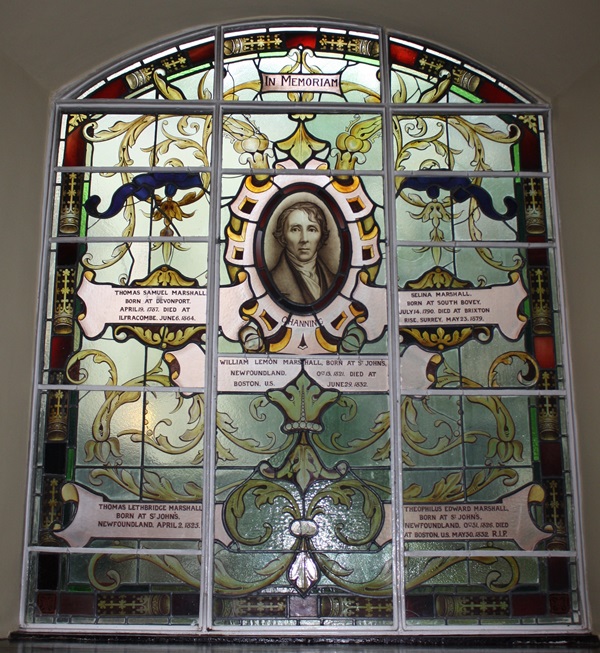
The window reads: Thomas Samuel Marshall, born at Devonport. April 19, 1787. Died at Ilfracombe, June 6 1864.
Thomas Lethbridge Marshall born at St Johns, Newfoundland. April 2 1825.
William Lemon Marshall, born at St Johns, Newfoundland. October 13 1821. Died at Boston U.S. June 29 1832.
Selina Marshall, born at South Bovey. June 14 1790. Died at Brixton Rise, Surrey. May 23 1879.
Theophilus Edward Marshall, born at St Johns, Newfoundland. October 31 1826. Died at Boston U.S. May 30 1832. R.I.P.
A stained-glass window.
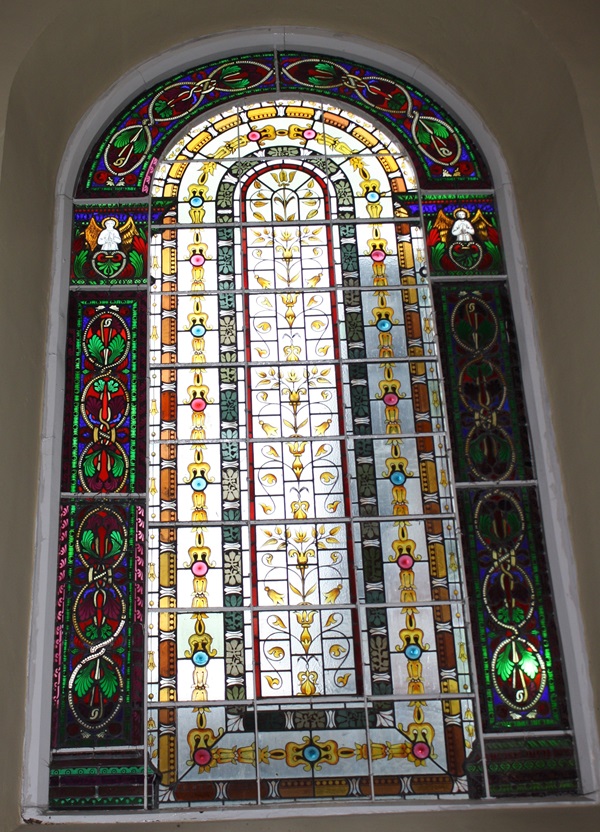
A stained-glass window in remembrance of the Long family.
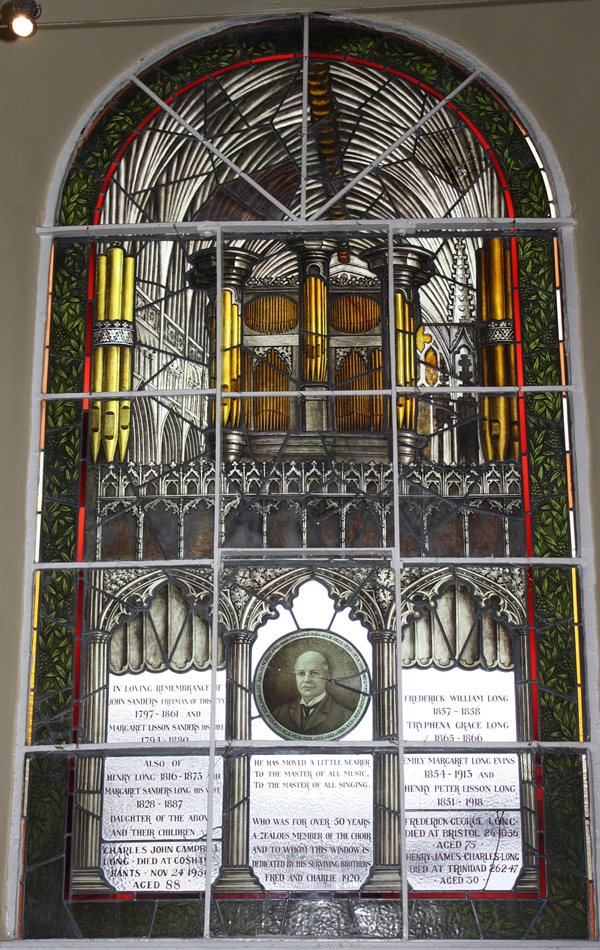
The window reads: In loving remembrance of John Sanders freeman of this city, 1797- 1861 and Margaret Lisson Sanders his wife, 1794- 1880.
Also of Henry Long 1816- 1873 and Margaret Sanders Long his wife, 1828- 1887. Daughter of the above and their children Charles John Campbell Long died at Cosham Hants, Nov 24 1959 aged 88.
He has moved a little nearer to the master of all music, to the master of all singing.
Who was for over 50 years a zealous member of the choir and to whom this window is dedicated by his surviving brothers Fred and Charlie 1920.
Frederick William long 1857- 1858, Tryphena Grace Long 1865- 1866.
Emily Margaret Long Evins 1854- 1913 and Henry Peter Lisson Long 1851- 1918.
Frederick George Long died at Bristol 26.10.36 aged 75. Henry James Charles Long died at the Trinidad 26.2.47 aged 30.
An historical plaque for James Peirce, taken from the chapel.
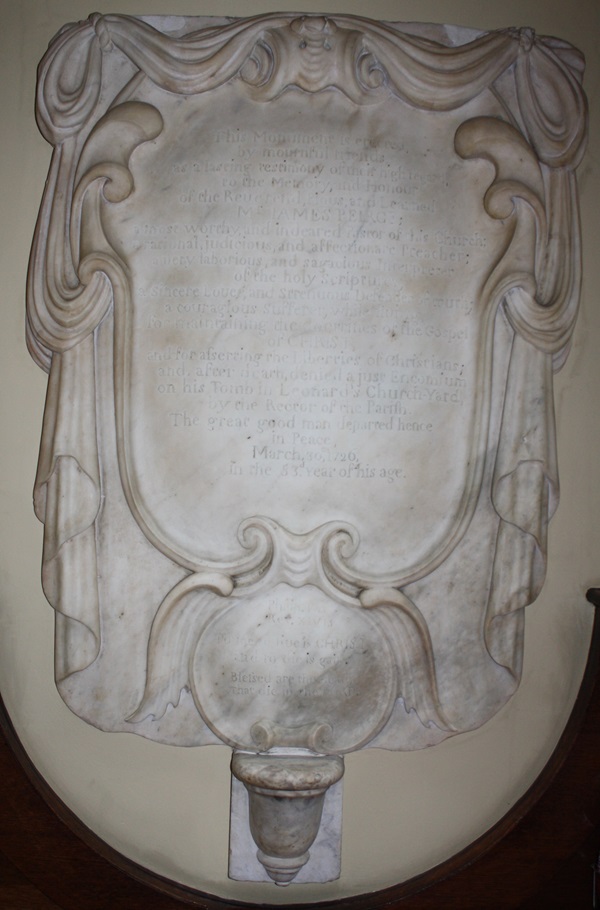
The plaque reads: This Monument is erected by mournful friends as a lasting testimony of their high regard, to the Memory and Honour of the Reverend, Pious and Learned. Mr James Peirce; a most worthy and indeared Pastor of this Church; a rational, judicious, and affectionate Preacher; a very laborious, and sagacious interpreter of the holy scriptures; a sincere Lover, and Stremnuous Defender of truth; a courageous sufferer, while living, for maintaining the doctrines of the Gospel of CHRIST; and for asserting the Liberties of Christians; and, after death, denied a just econium on his Tomb in Leonard’s Church- Yard, by the Rector or the Parish. The great good man departed hence in peace, March, 30th, 1726, in the 53rd year of his age.
Philip. 1 21
Rev. XIV 13
To me to live is CHRIST, and to die is gain.
Blessed are the dead, that die in the LORD.
An historical plaque for James Manning, taken from the chapel.
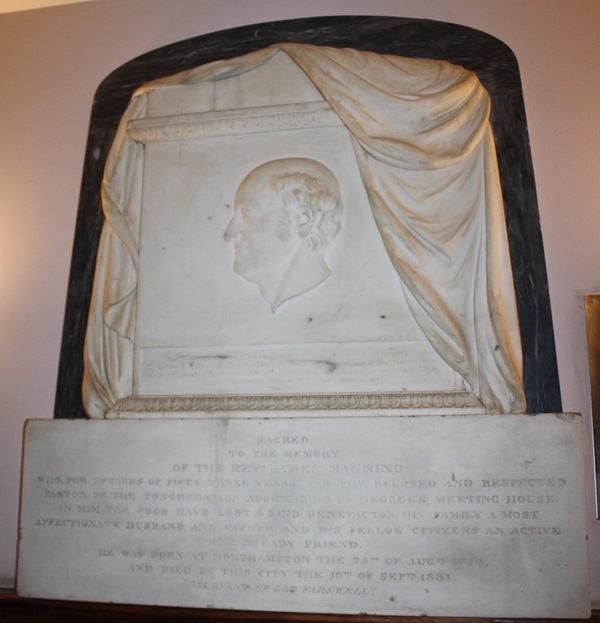
The plaque reads: ”And now my fellow Christians of all denominations Farewell – My beloved Wife and Children fare ye well. May I meet you round the throne of our reconciled Father with filial reverence and mutual congratulations. Again Farewell – Farewell!!” J.Manning
Sacred to the memory of the RevD James Manning who for upwards of fifty three years was the beloved and respected pastor of the congregation assembling in the George’s Meeting House. In him the poor have lost a kind benefactor. His family a most affectionate husband and father, and his fellow citizens an active and steady friend. He was born at Northampton the 25th August 1754. And died in this city the 10th of September 1851. “Servant of god farewell”.
An historical plaque for Lant Carpenter, taken from the chapel.
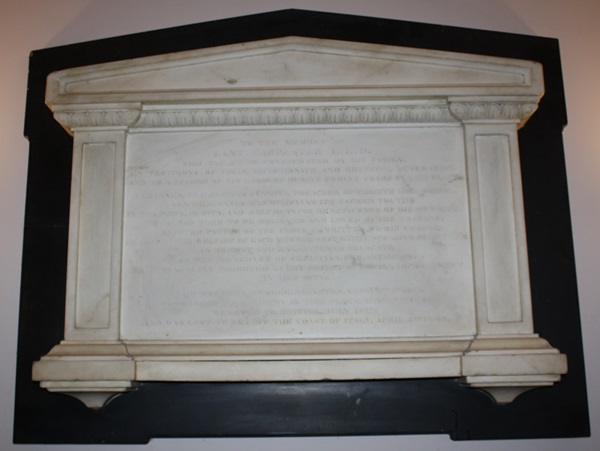
The plaque reads: To the memory of Lant Carpenter L.L.D.
This tablet is consecrated by his family, in his testimony of their affectionate and grateful veneration, and as a record of his labours during twelve years in this place. A learned, zealous and faithful preacher of Christ’s holy gospel and diligently exemplifying its sacred truths in the pity, purity, and self- denying beneficence of his own life, he cause them to be believed and loved by his hearers: a devoted pastor of the flock committed to his charge. He sought the welfare of each member of it with unceasing solicitude: an ardent and enlightened advocate of the principles of Christian philanthropy, he strenuously promoted every object of social improvement in this city. He was born at Kidderminster, September 2nd 1780: commences his ministry in this place. April 7th 1805: removed to Bristol. July 1817: and was lost at sea off the coast of Italy, April 5th 1840.
An historical plaque for Sarah Barham, taken from the chapel.
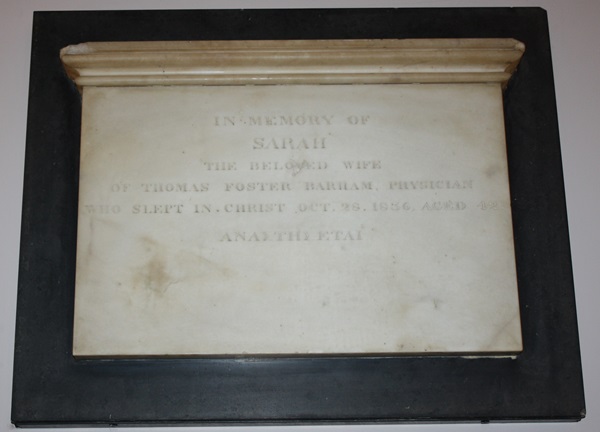
The plaque reads: In memory of Sarah. The beloved wife of Thomas Foster Barham, Physician, who slept in Christ October 28 1836, aged 42.
An historical plaque for Mary Gray, taken from the chapel.
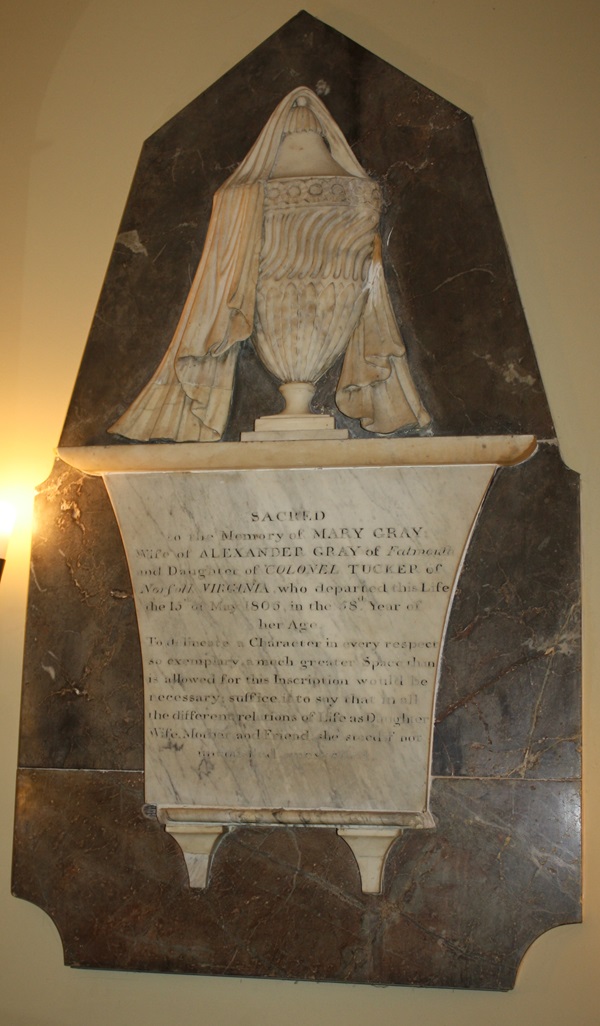
The plaque reads: Sacred to the memory of Mary Gray. Wife of Alexander Gray of Falmouth and daughter of Colonel Tucker of Norfolk Virginia, who departed this life on the 15th of May 1806, in the 58th year of her life.
To delineate a character in every respect so exemplary a much greater space than is allowed for this inscription would be necessary: suffice it to say that in all the different relations of life as daughter, wife, mother and friend she stood if not unequalled, unexcelled.
Framed drawing, photograph and text about George’s Meeting House.
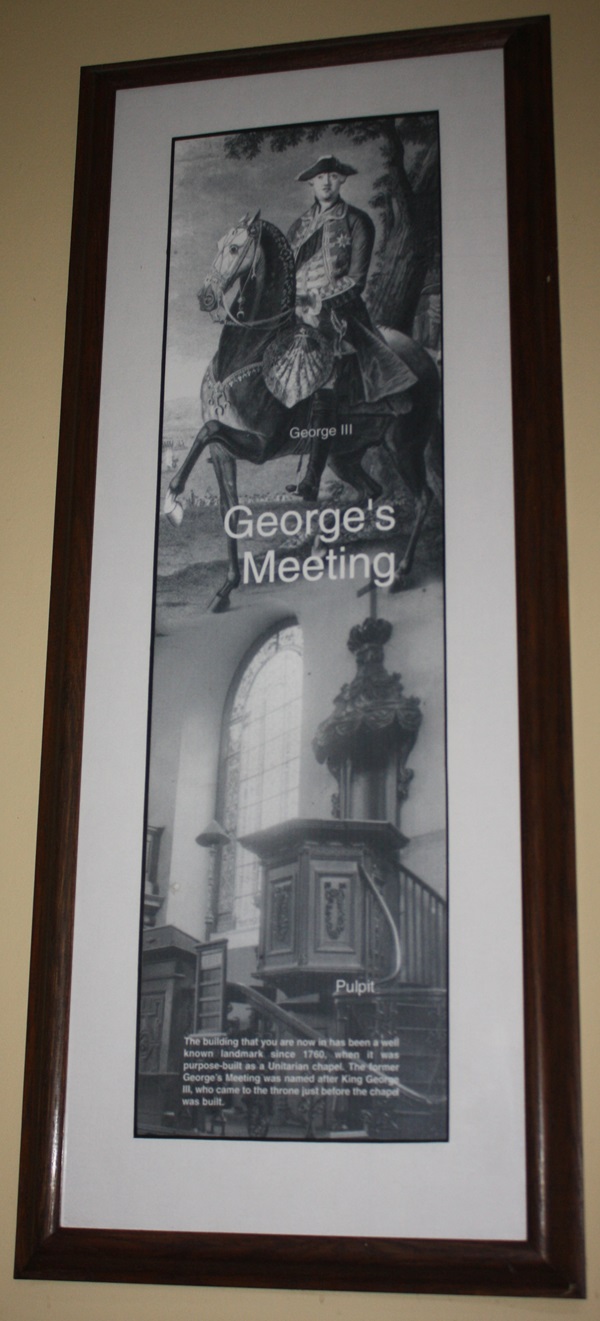
The text reads: The building that you are now in has been a well known landmark since 1760, when it was purpose- built as a Unitarian chapel. The former George’s Meeting was named after King George III, who came to the throne just before the chapel was built.
Top: George III
Bottom: Pulpit
A framed drawing of Exeter in the 16th century.
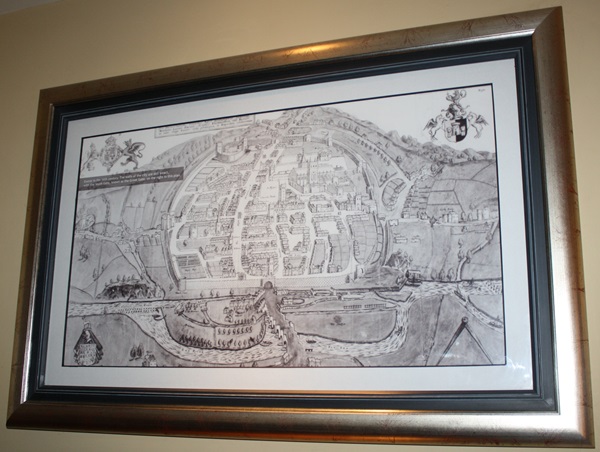
The text reads: Exeter in the 16th century. The walls of the city are still intact, with the South Gate, known as the Great Gate, on the right in this plan.
A framed drawing of Exeter, with the Roman wall and Exeter’s coat of arms.
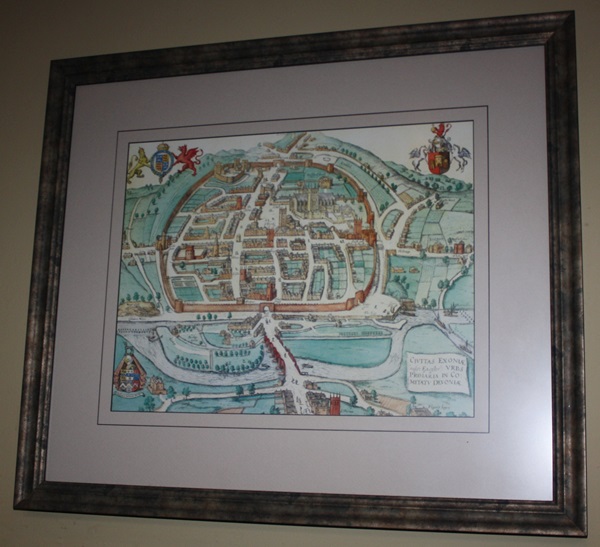
Framed drawings and text about the Romans.
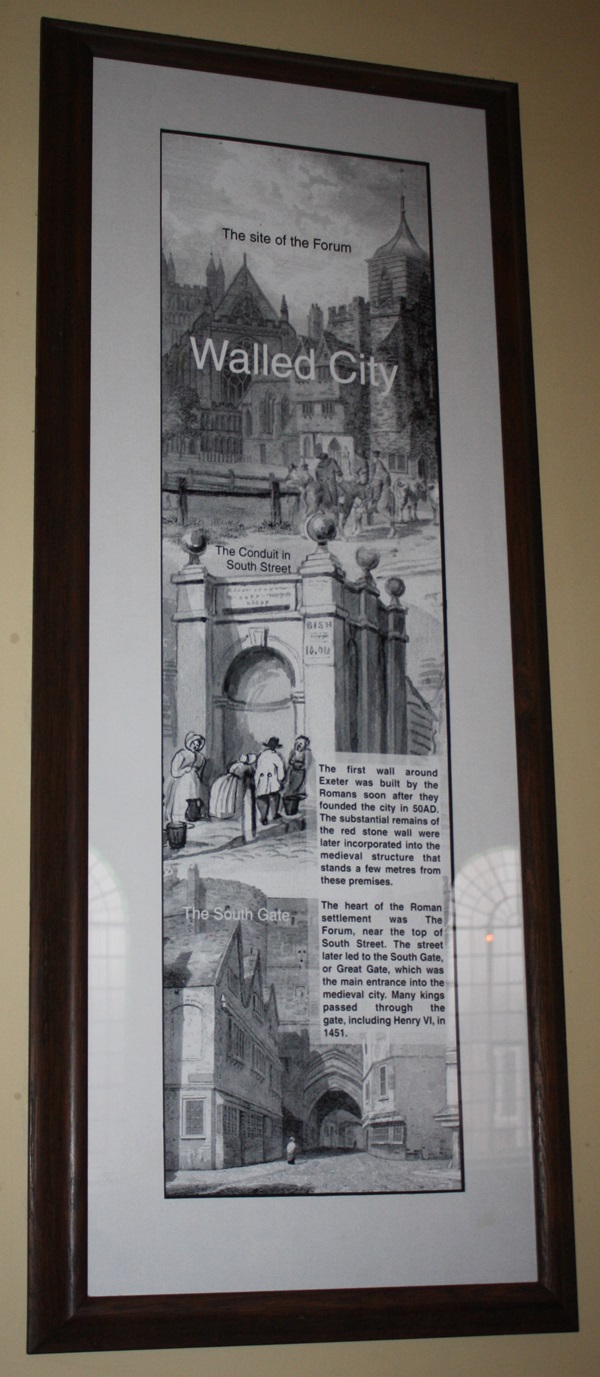
The text reads: The first wall around Exeter was built by the Romans soon after they founded the city in 50AD. The substantial remains of the red stone wall were later incorporated into the medieval structure that stands a few metres from these premises.
The heart of the Roman settlement was The Forum, near the top of South Street. The street later led to the South Gate, or Great Gate, which was the main entrance into the medieval city. Many kings passed through the gate, including henry VI, in 1415.
Top: The site of the Forum
Centre: The Conduit in South Street
Bottom: The South Gate
A framed drawing and text about the South Gate.
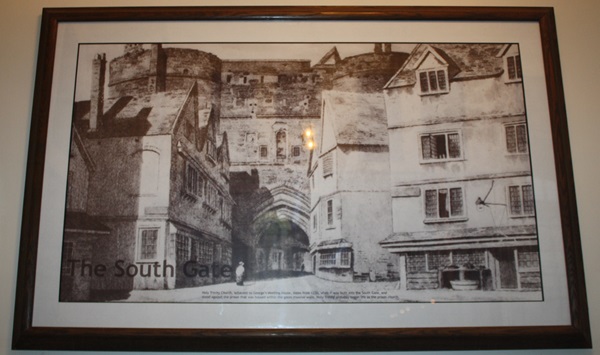
The text reads: Holy Trinity Church, adjacent to George’s Meeting House, dates from 1220, when it was built into the South Gate, and stood against the prison that was housed within the gates massive walls. Holy Trinity probably began life as the church prison.
Framed drawings, photographs and text about the guildhall.
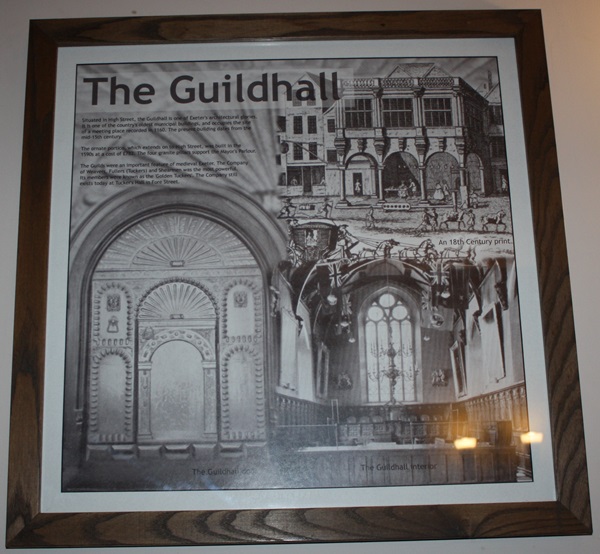
The text reads: Situated in high Street, the Guildhall is one of Exeter’s architectural glories. It is one of the county’s oldest maniple buildings, and occupies the site of a meeting place recorded in 1160. The present building dates from the mid-15th century.
The ornate portico, which extends on to High Street, was built in the 1590s at a cost of £782. The four granite pillars support the Mayors Parlour.
The Guilds were an important feature of medieval Exeter. The Company of Weavers, Fullers (Tuckers) and Shearman was the most powerful. Its members were known as the ‘Golden Truckers’. The Company still exists today at Tucker’s Hall in Fore Street.
Top: An 18th century print
Left: The Guildhall door
Right: The Guildhall interior
A framed drawing and text about High Street and the Guildhall in c1830.
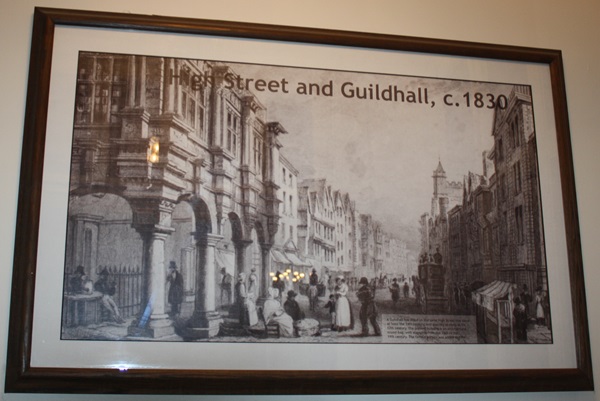
The text reads: A Guildhall has stood on the same High Street site since at least the 14th century, and possibly as early as the 12th century. The present building is an architectural mixed- bag, with elements from the 15th to the 19th century. The famous portico was added in 1594.
A framed drawing and text about Mol’s Coffee House and the guildhall.
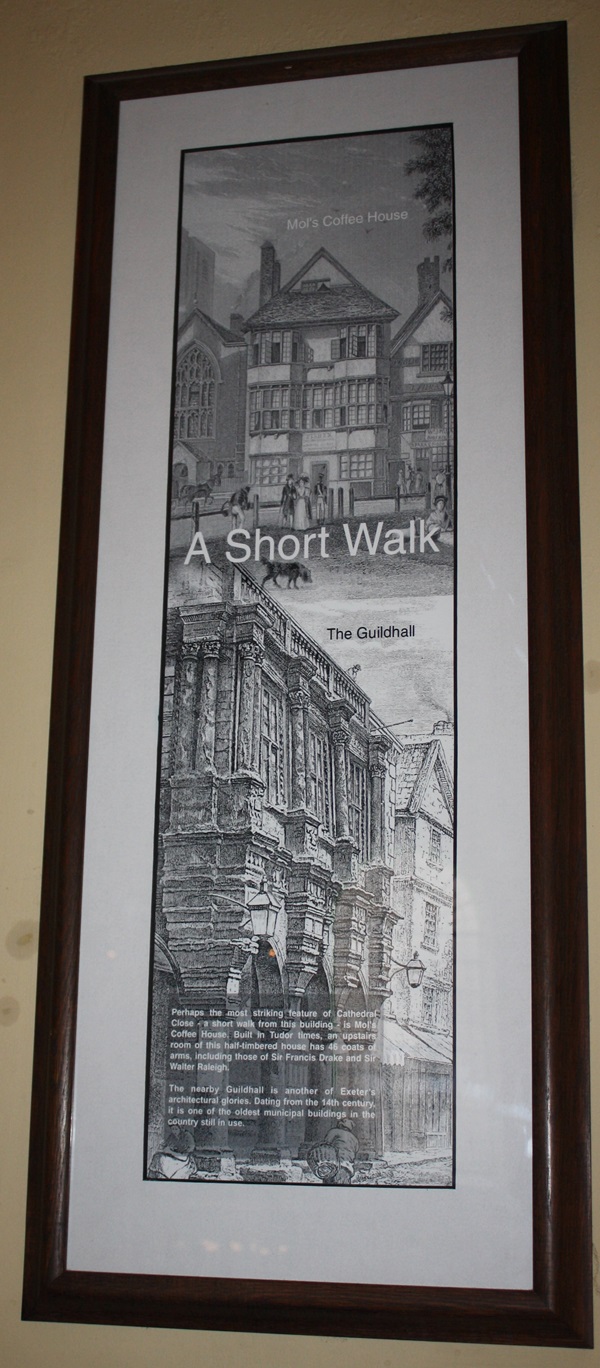
The text reads: Perhaps the most striking feature of Cathedral Close – a short walk from this building – is Mol’s Coffee House. Built in Tudor times, an upstairs room of this half-timbered house has 46 coats of arms, including those of Sir Francis Drake and Sir Walter Raleigh.
The nearby Guildhall is another of Exeter’s architectural glories. Dating from the 14th century, it is one of the oldest municipal buildings in the country still in use.
Top: Mol’s Coffee House
Bottom: The Guildhall
Framed drawings and text about Sir Redvers Henry Buller.
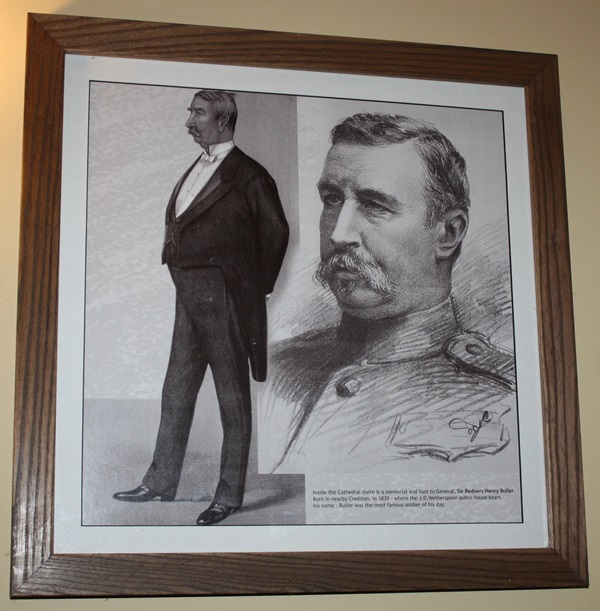
The text reads: Inside the Cathedral there is a memorial and bust to General, Sir Redvers Henry Buller. Born in nearby Crediton, in 1839 – where the J. D. Wetherspoon public house bears his name – Buller was the most famous soldier of his day.
Framed drawings and text about Richard Hooker.
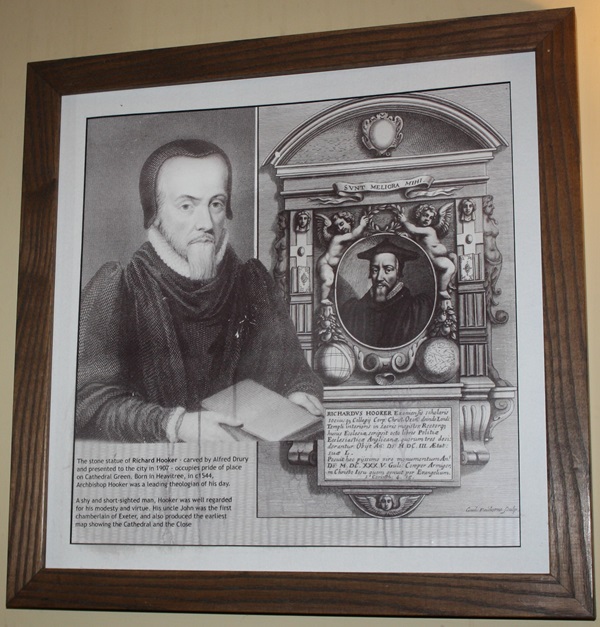
The text reads: The stone statue of Richard Hooker – carved by Alfred Drury and presented to the city in 1907 – occupies pride of place on cathedral Green. Born in Heavitree, in c1544, Archbishop Hooker was a leading theologian of his day.
A shy and short- sighted man, Hooker was well regarded for his modesty and virtue. His uncle John was the first chamberlain of Exeter, and also produced the earliest map showing the Cathedral and the Close.
Framed drawings, photographs and text about Charles Dickens.
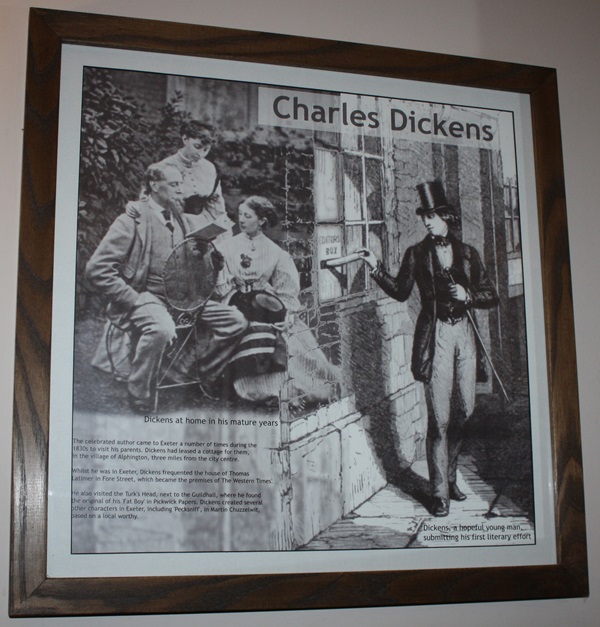
The text reads: The celebrated author came to Exeter a number of times during the 1830s to visit his parents. Dickens had leased a cottage for them, in the village of Alphington, three miles from the city centre.
Whilst he was in Exeter, Dickens frequented the house of Thomas Latimer in Fore Street, which became the premises of The Western Times.
He also visited the Turk’s Head, next to the Guildhall, where he found the original of his ‘Fat Boy’ in Pickwick Papers. Dickens created several other characters in Exeter, including ‘Pecksniff’, in Martin Chuzzelwit, based on a local worthy.
Left: Dickens at his home in his mature years
Right: Dickens, a hopeful young man, submitting his first literary effort
Framed drawings and text about Charles Dickens and Sir John Bowring.
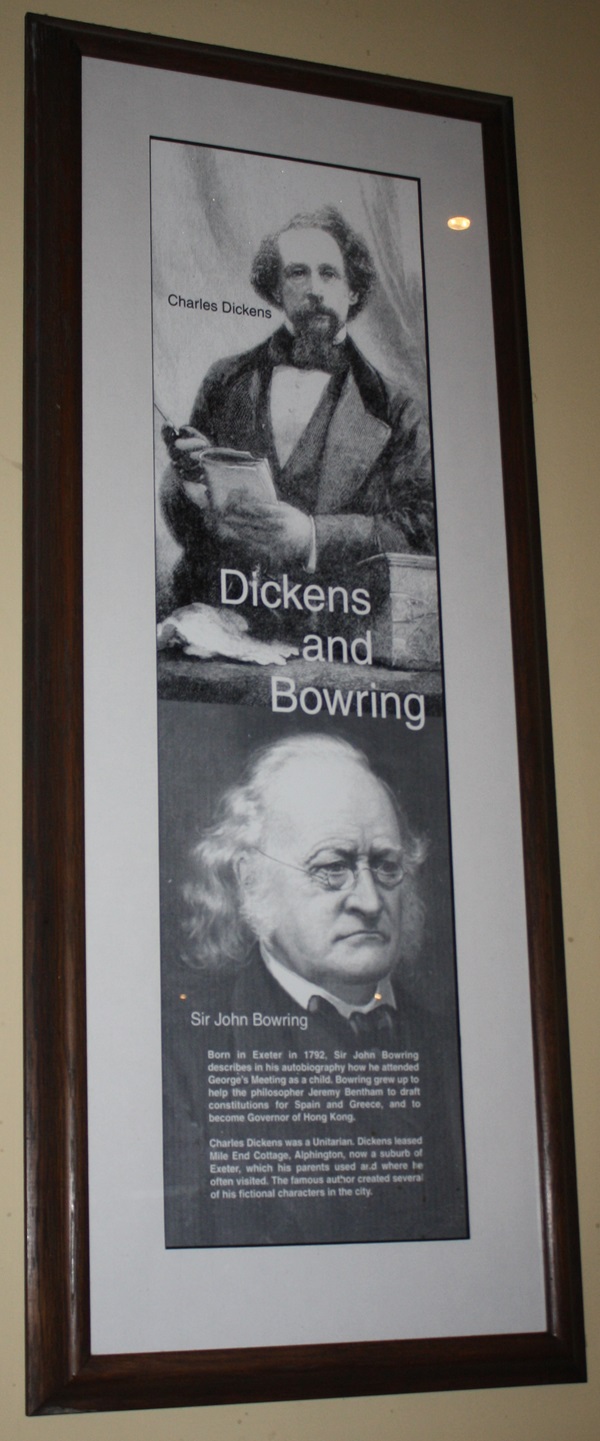
The text reads: Born in Exeter in 1792, Sir John Bowring describes in his autobiography how he attended George’s Meeting as a child. Bowring grew up to help the philosopher Jeremy Bentham to draft constitutions for Spain and Greece, and to become Governor of Hong Kong.
Charles Dickens was a Unitarian. Dickens leased Mile End Cottage, Alphington, now a suburb of Exeter, which his parents used and where he often visited. The famous author created several of his fictional characters in the city.
Top: Charles Dickens
Bottom: Sir John Bowring
Framed drawings and text about the Unitarians.
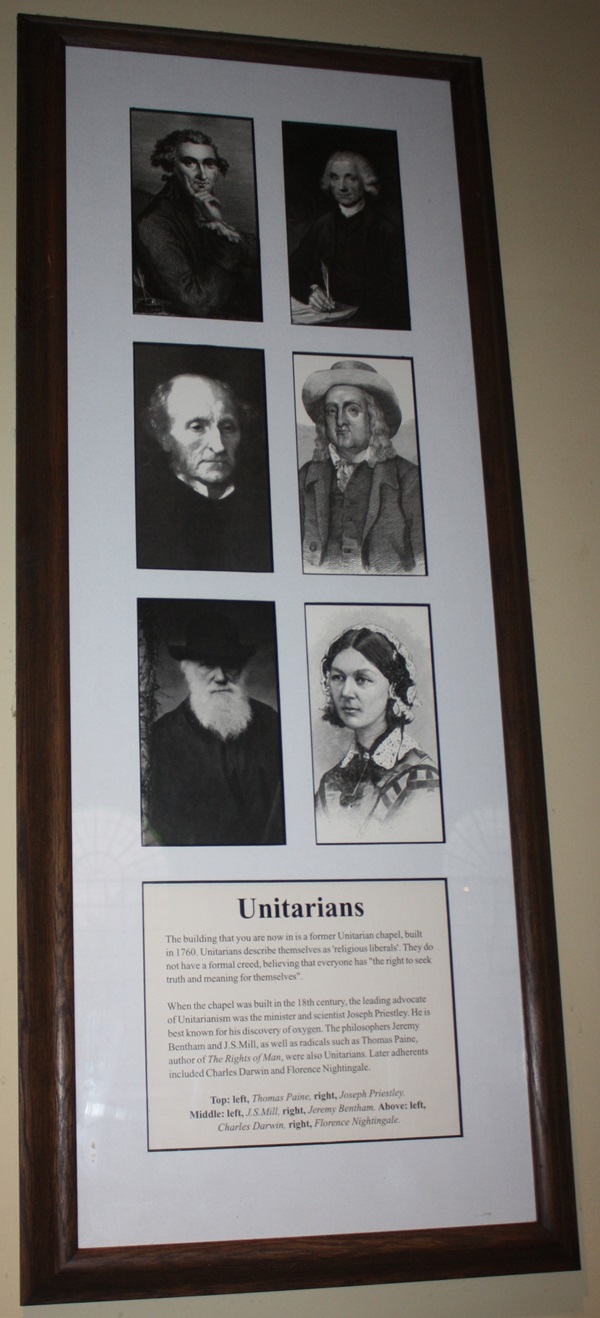
The text reads: The building that you are now in is a former Unitarian chapel, built in 1760. Unitarians describe themselves as ‘religious liberals’. They do not have a formal creed, believing that everyone has “the right to see truth and meaning for themselves”.
When the chapel was built in the 18th century, the leading advocate of Unitarianism was the minister and scientist Joseph Priestley. He is best known for his discovery of oxygen. The philosophers Jeremy Bentham and J.S. Mill, as well as radicals such as Thomas Paine, author or The Rights of Man, were also Unitarians. Later adherents included Charles Darwin and Florence Nightingale.
Top: left, Thomas Paine, right, Joseph Priestley. Middle: left, J.S. Mill, right, Jeremy Bentham.
Above: left, Charles Darwin, right, Florence Nightingale.
A framed drawing and text about the cathedrals built on this site.
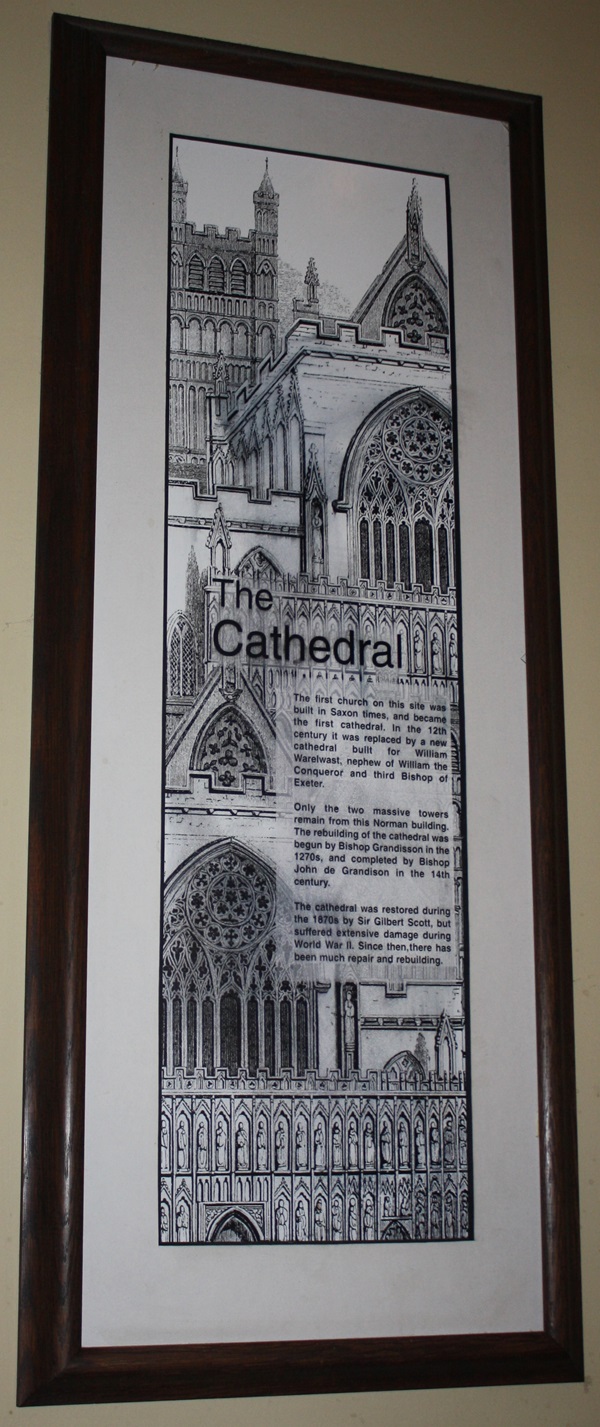
The text reads: The first church on this site was built in Saxon times, and became the first cathedral. In the 12th century it was replaced by a new cathedral built for William Warelwast, nephew of William the Conqueror and third Bishop of Exeter.
Only the two massive towers remain from this Norman building. The rebuilding of the cathedral was begun by Bishop Grandison in the 1270s, and completed by Bishop John de Grandison in the 14th century.
The cathedral was restored during the 1870s by Sir Gilbert Scott, but suffered extensive damage during World War 2. Since then, there has been much repair and rebuilding.
Framed photographs of when the building was used as a chapel.
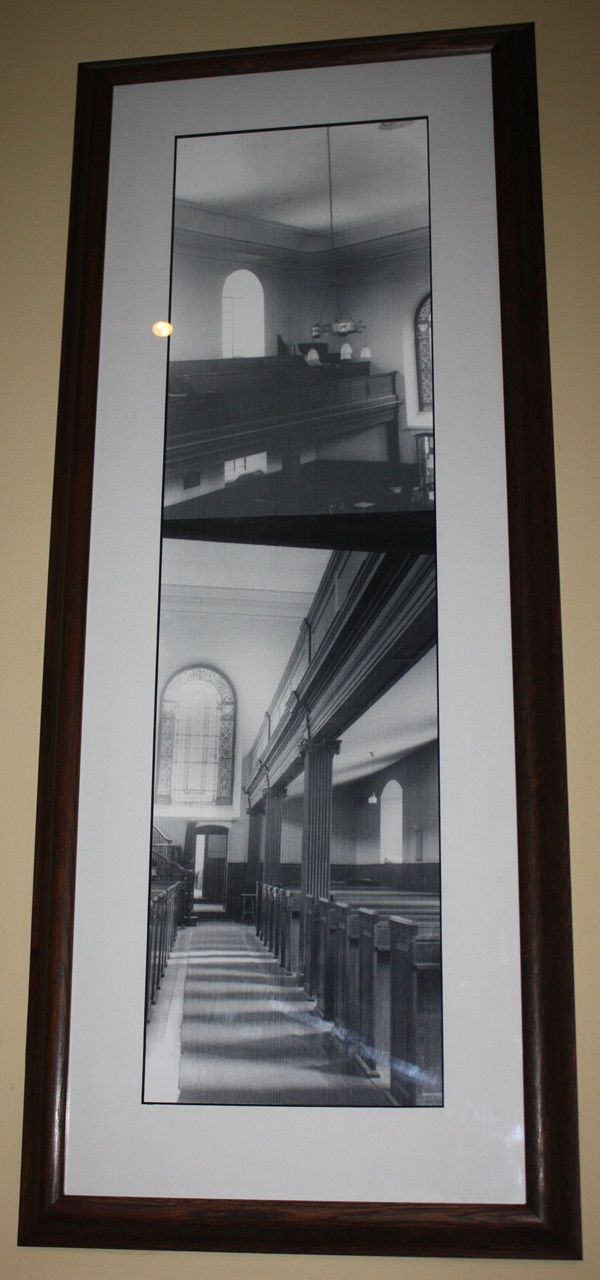
The original pulpit and stained-glass windows.
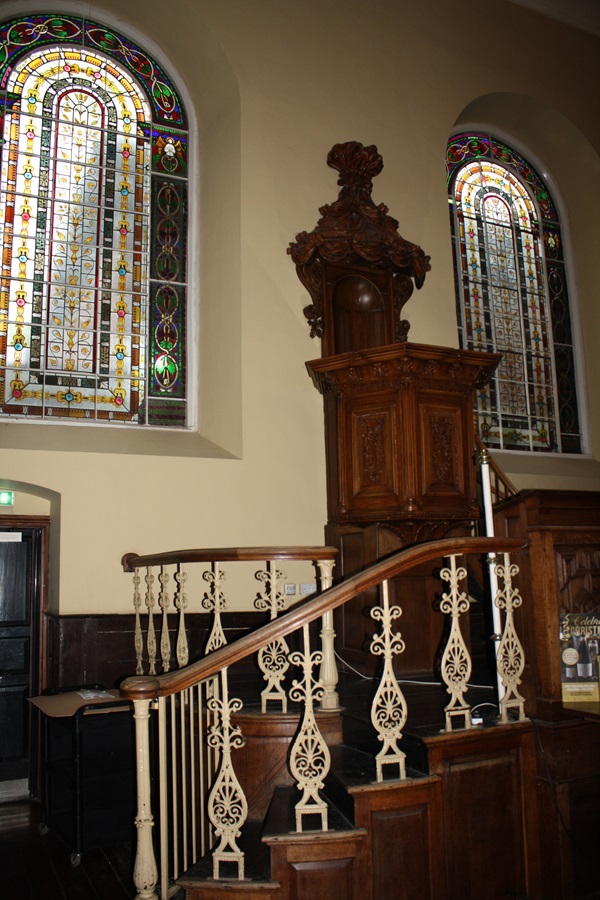
The original pulpit and stained-glass windows.
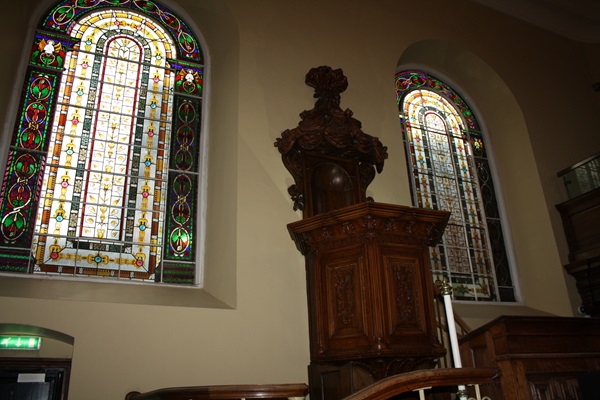
The original pulpit and stained-glass windows.
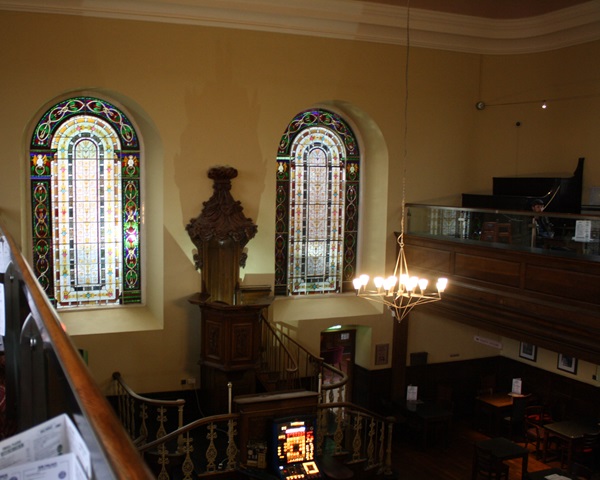
An internal photo of the upper floor.
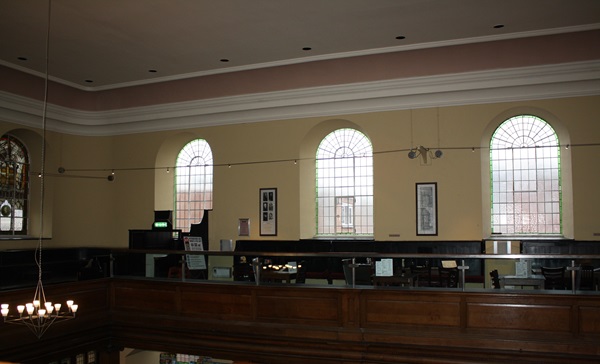
The original window fittings can be seen, and the balcony layout.
An original pew taken from the chapel, now used as seating.
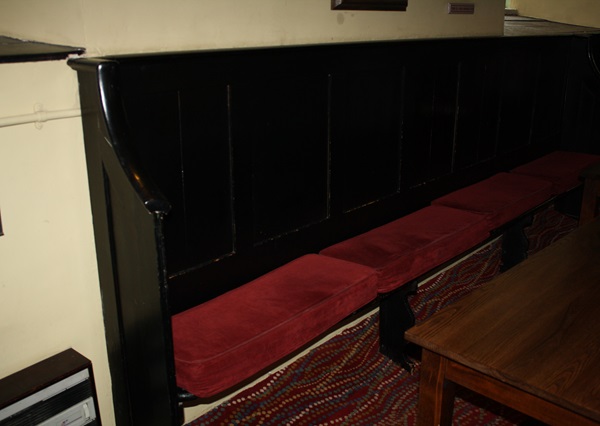
An original clock feature.
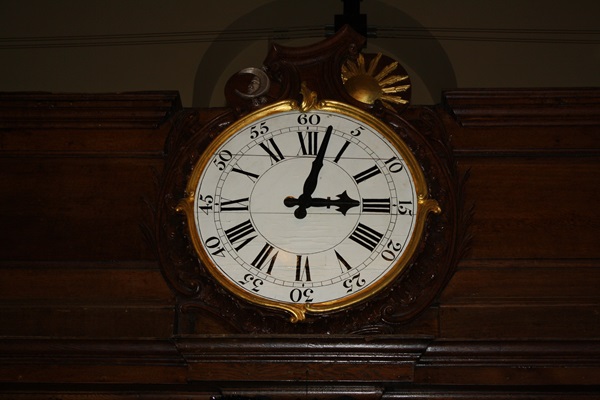
External photo of the building – the hanging board.
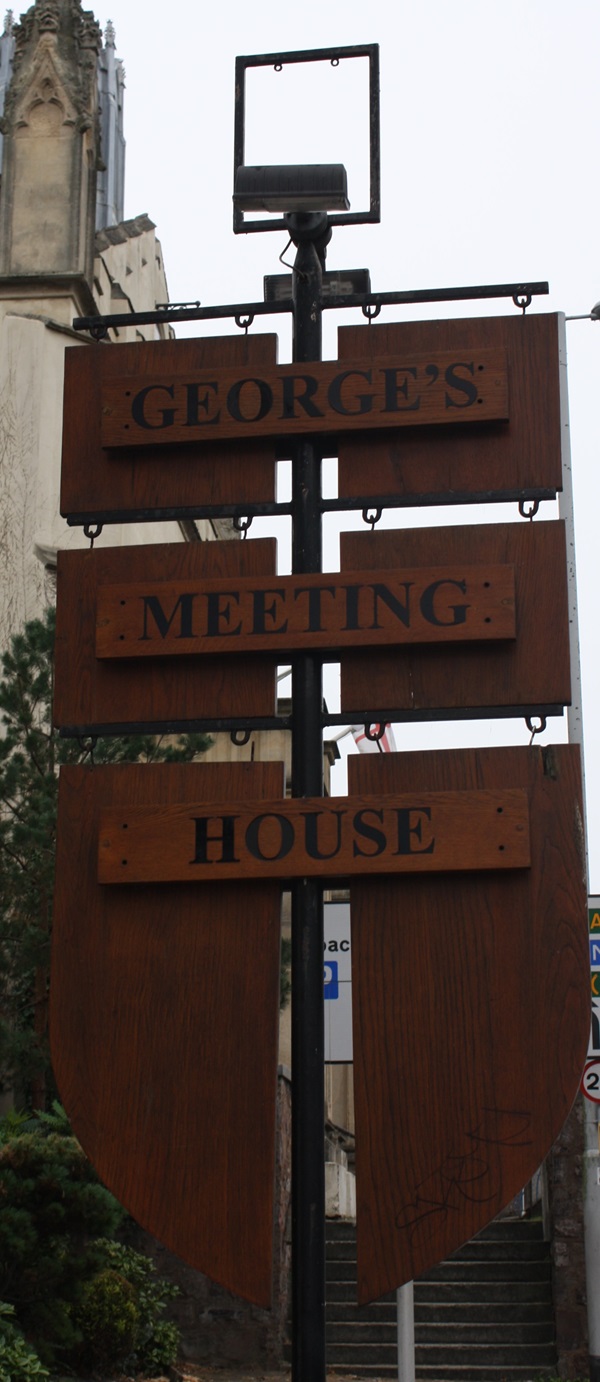
External photo of the building – front.
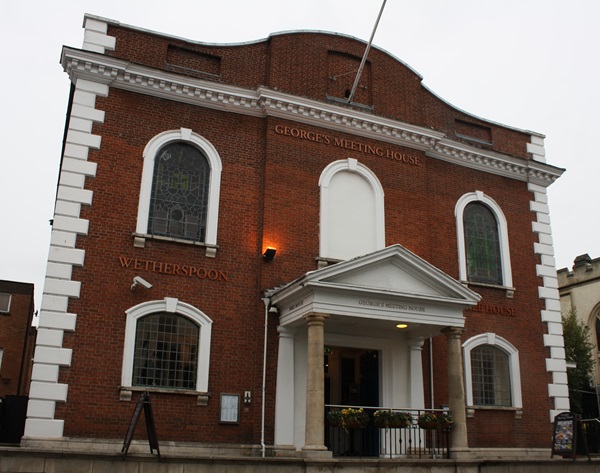
If you have information on the history of this pub, then we’d like you to share it with us. Please e-mail all information to: pubhistories@jdwetherspoon.co.uk